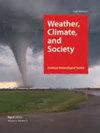2018-2020年“旷日持久”厄尔尼诺Niño事件的背景:澳大利亚干旱、陆地、海洋和生态生理影响。
IF 1.9
4区 地球科学
Q3 ENVIRONMENTAL STUDIES
引用次数: 0
摘要
从2018年3月至4月至2020年4月至5月,El Niño发生了一场“旷日持久”的事件。这表现在El Niño相位的两个组成部分对印度-太平洋的相互关联的影响上。2018年和2019年的印度洋正偶极子(IODs)抑制了西北云带的形成和澳大利亚南部的降雨,持续的遥相关,以及Niño 4区域海温(SST)正异常和澳大利亚东部强烈下沉所产生的对流增强,加剧了澳大利亚的干旱。与通常持续12-18个月的“经典”厄尔尼诺Niño南方涛动(ENSO)事件一样,持续2年以上的“长期”ENSO事件对整个印度-太平洋地区的社会和环境表现出类似的影响模式,并经常扩展到全球。本研究的后半部分将2018-2020年“长期”厄尔尼诺Niño事件对澳大利亚陆地农业和海洋生态生理环境的影响置于更广泛的背景下。这些影响往往不仅受到ENSO事件和事件的直接影响,而且受到相互关联的局地和区域海洋-大气相互作用和天气天气模式的调节。尽管“长期”ENSO事件的指数通常比那些主要的“经典”ENSO事件的强度要弱,但前者持续时间较长,也带来了一系列问题。因此,迫切需要调查预测“长期”ENSO事件的可能性,特别是在2020年中期至2022年目前期间,经历了一次具有近全球影响的重大“长期”La Niña事件。本文章由计算机程序翻译,如有差异,请以英文原文为准。
The context of the 2018-2020 ‘protracted’ El Niño episode: Australian drought, terrestrial, marine, and ecophysiological impacts.
A ‘protracted’ El Niño episode occurred from March-April 2018 until April-May 2020. It was manifest by the interlinked Indo-Pacific influences of two components of El Niño phases. Positive Indian Ocean Dipoles (IODs) in 2018 and 2019, suppressed the formation of northwest cloud bands and southern Australia rainfall, and a persistent teleconnection, with enhanced convection generated by positive Niño 4 region sea surface temperature (SST) anomalies and strong subsidence over eastern Australia, exacerbated this Australian drought. As with ‘classical’ El Niño Southern Oscillation (ENSO) events, which usually last 12-18 months, ‘protracted’ ENSO episodes, which last for more than 2 years, show a similar pattern of impacts on society and the environment across the Indo-Pacific domain, and often extend globally. The second half of this study puts the impact of the 2018-2020 ‘protracted’ El Niño episode on both the Australian terrestrial agricultural and marine ecophysiological environments in a broader context. These impacts are often not only modulated by the direct effects of ENSO events and episodes, but by interrelated local to region ocean-atmosphere interactions and synoptic weather patterns. Even though the indices of ‘protracted’ ENSO episodes are often weaker in magnitude than those of major ‘classical’ ENSO events, it is the longer duration of the former which poses its own set of problems. Thus, there is an urgent need to investigate the potential to forecast ‘protracted’ ENSO episodes, particularly when the mid-2020 to current 2022 period has been experiencing a major ‘protracted’ La Niña episode with near-global impacts.
求助全文
通过发布文献求助,成功后即可免费获取论文全文。
去求助
来源期刊

Weather Climate and Society
METEOROLOGY & ATMOSPHERIC SCIENCES-
CiteScore
3.40
自引率
13.60%
发文量
95
审稿时长
>12 weeks
期刊介绍:
Weather, Climate, and Society (WCAS) publishes research that encompasses economics, policy analysis, political science, history, and institutional, social, and behavioral scholarship relating to weather and climate, including climate change. Contributions must include original social science research, evidence-based analysis, and relevance to the interactions of weather and climate with society.
 求助内容:
求助内容: 应助结果提醒方式:
应助结果提醒方式:


